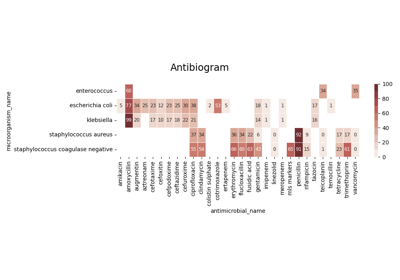pyamr.core.sart pyamr.core.sart =============== ===============
Classes
- class pyamr.core.sart.SART(column_specimen='SPECIMEN', column_microorganism='MICROORGANISM', column_antimicrobial='ANTIMICROBIAL', column_date='DATE', column_outcome='SENSITIVITY', column_resistance='RESISTANCE')[source]
Single Antimicrobial Resistance Trend.
Methods:
compute(dataframe[, period, shift, cdate, ...])Computes Single Antimicrobial Resistance Index.
- compute(dataframe, period='180D', shift='30D', cdate=None, return_objects=True, **kwargs)[source]
Computes Single Antimicrobial Resistance Index.
Todo
Add parameters to rolling!
Place value at the left, center, right of window?
Ensure that works when time gaps present!
Carefull with various indexes!
- Parameters:
dataframe (pd.DataFrame) – It might receive two different types of DataFrames. The first option is a DataFrame with the raw susceptibility test records where the interpretation (‘sensitive’, ‘intermediate’, ‘resistant’) that will be used to compute the sari. The second option is a DataFrame with the sari values already computed.
shift (str) – Frequency value to pass to pd.Grouper.
period (str, int) – Window value to pass to pd.rolling.
cdate (string, default=None) – The column that will be used as date.
return_frequencies (boolean, default=True) – Whether to return the frequencies or just the resistance index.
strategy (string or func, default=’hard’) – The method used to compute sari. The possible options are ‘soft’, ‘medium’ and ‘hard’. In addition, a function with the following signature func(DataFrame, **kwargs) can be passed.
softas R / R+I+Smediumas R / R+Shardas R+I / R+I+Sotheras R+0.5I / R+0.5I+S [Not yet]
**kwargs (arguments to pass the strategy function.)
- Returns:
The resistance index (pd.Series) or a pd.DataFrame with the resistance index (sari) and the frequencies.
- Return type:
pd.Series or pd.DataFrame
